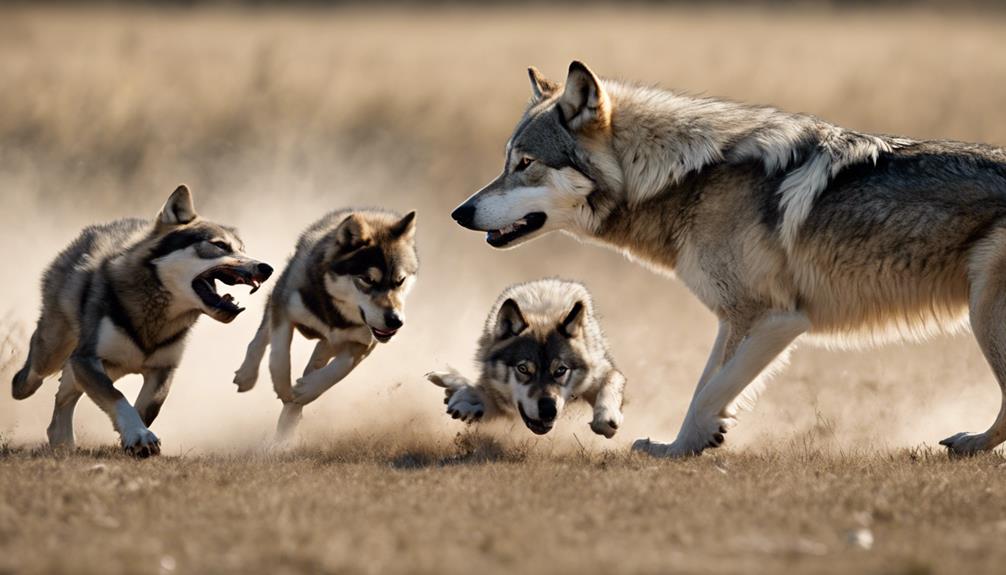Eight Essential Insights Into Canine Psychology & Behavior
Unlock the mysterious language of your furry companion's behavior through understanding their subtle cues. By diving into the realm of canine psychology and behavior, you'll uncover a world that is both fascinating and enlightening.
From deciphering communication signals to unraveling the complexities of pack dynamics, each insight offers a glimpse into the intricate workings of your dog's mind. Get ready to gain a deeper appreciation for your canine friend as we explore the eight essential insights that shape their behavior and interactions with the world around them.
Canine Communication Signals
Understanding canine communication signals can significantly enhance your ability to interpret your dog's emotions and intentions accurately. Canine facial expressions play a crucial role in conveying feelings such as happiness, fear, or aggression.
For example, a relaxed mouth and soft eyes typically indicate a content and friendly mood, while a wrinkled muzzle or bared teeth might signal discomfort or aggression. Tail wagging meanings are also essential to comprehend. Contrary to popular belief, a wagging tail doesn't always mean a dog is happy.
The speed, height, and direction of the wag can provide insights into your dog's emotional state. A high, fast wag usually signifies excitement or agitation, while a slow, low wag might indicate insecurity or submission. By paying attention to these subtle cues in your dog's body language, you can develop a deeper understanding of their thoughts and feelings, strengthening the bond between you and your furry companion.
Pack Dynamics Influence Behavior
Exploring how pack dynamics influence a dog's behavior can provide valuable insights into their social interactions and instincts. Dogs have inherited certain dominance submission dynamics from their wolf ancestors, shaping their behavior within packs. Understanding these dynamics can help you decipher your furry friend's actions and reactions.
Here are three key points to consider when delving into pack dynamics:
- Hierarchy: Dogs naturally establish a pecking order within a pack based on dominance and submission. Recognizing where your dog fits into this hierarchy can aid in training and addressing behavioral issues.
- Leadership: Pack leadership principles play a significant role in how dogs interact with humans and other animals. Establishing yourself as the pack leader can promote better behavior and obedience from your dog.
- Socialization: Dogs thrive on social interactions, mirroring the pack dynamics in their relationships with other canines and even humans. Encouraging positive socialization experiences can help your dog develop well-adjusted behaviors.
Canine Social Hierarchy Insights
Within a dog pack, the social hierarchy establishes clear roles and dynamics that influence behavior and interactions among members. Dogs rely on dominance-submission dynamics to maintain order within the pack. The pack leader role is crucial in setting boundaries, resolving conflicts, and providing direction to the group.
Understanding the pack leader role is essential in comprehending canine social behavior. The pack leader isn't necessarily the most aggressive or strongest dog but rather the one who exhibits confident and consistent leadership. Dogs look to the pack leader for guidance and protection, and this role helps prevent chaos and ensure cooperation within the group.
In a household with multiple dogs or when introducing a new dog, recognizing the pack dynamics can aid in creating a harmonious environment. By acknowledging and respecting the existing hierarchy, you can help prevent unnecessary conflicts and promote positive interactions among your canine companions. Remember, understanding the pack leader role and dominance-submission dynamics is key to fostering a peaceful and balanced canine social structure.
Understanding Canine Body Language
To better comprehend your dog's emotions and intentions, observe their body language closely. Understanding canine body language can help you build a stronger bond with your furry friend and address any potential behavioral issues.
Here are some key insights to help you interpret your dog's signals effectively:
- Canine stress indicators: Dogs may exhibit various signs of stress, such as yawning, lip licking, or a tucked tail. Recognizing these stress indicators can help you alleviate your dog's anxiety and create a more comfortable environment for them.
- Behavioral cues: Pay attention to your dog's posture, tail position, and facial expressions to decipher their feelings. A wagging tail doesn't always mean happiness; it could also indicate excitement, nervousness, or even aggression. Understanding these behavioral cues will enable you to respond appropriately to your dog's needs.
- Communication through body language: Dogs primarily communicate through body language, so being attuned to their movements and gestures is crucial for effective interaction. By learning to read your dog's body language, you can strengthen your relationship and ensure a harmonious companionship.
Impact of Environment on Behavior
Understanding your dog's behavior is intricately linked to the environment they're in, as it significantly influences how they act and react in various situations. Environmental enrichment strategies play a crucial role in shaping your dog's behavior positively. Providing mental stimulation through interactive toys, puzzle feeders, and regular exercise can prevent boredom and destructive behaviors.
Behavior modification techniques are essential when addressing unwanted behaviors in your dog. Positive reinforcement, such as rewarding good behavior with treats or praise, can effectively encourage desired actions. On the other hand, aversive training methods, like yelling or physical punishment, can lead to fear and aggression in your dog.
Socialization practices are key in shaping your dog's behavior towards other animals and people. Exposing your dog to different environments, sounds, and experiences from a young age can help prevent fear and anxiety later in life. Additionally, proper socialization can improve your dog's ability to communicate and interact with others effectively.
Canine Behavioral Development Stages
Navigating through your dog's behavioral development stages can provide valuable insights into their growth and behavior patterns. Understanding these stages, from puppy training to adolescent behavior, can help you support your furry friend effectively.
Here are three key points to consider:
- Puppy Training: The early stages of your dog's life are crucial for setting the foundation of their behavior. Positive reinforcement techniques during this period can shape their learning abilities and socialization skills for the rest of their life.
- Adolescent Behavior: As your puppy transitions into adolescence, you may notice some challenging behaviors emerging. This phase is marked by increased independence and testing boundaries. Consistent training and patience are essential to guide them through this stage successfully.
- Developmental Milestones: Keep track of your dog's developmental milestones, such as teething, fear periods, and sexual maturity. Understanding these stages can help you tailor your training approach to meet their evolving needs and behaviors.
Instinctual Versus Learned Behavior

Explore how your dog's actions are influenced by inherent instincts versus learned behaviors. Canine behavior is a complex interplay between nature and nurture, where genetic predispositions interact with environmental influences.
Instinctual behaviors are those that are hard-wired into your dog's genetic makeup, such as hunting, herding, or territorial instincts. These behaviors are often automatic responses to specific stimuli and are crucial for survival in the wild.
On the other hand, learned behaviors are acquired through interactions with the environment, training, and socialization. Dogs can learn to perform tricks, follow commands, or exhibit specific behaviors based on their experiences.
Nature versus nurture plays a significant role in shaping your dog's behavior. While some behaviors are influenced by genetic predispositions, others are a result of environmental factors.
Understanding the balance between instinctual and learned behaviors can help you better comprehend your dog's actions and tailor training methods to suit their needs. By recognizing the interplay between nature and nurture, you can create a harmonious environment that promotes positive behaviors in your furry companion.
Canine Aggression Triggers
Your dog's aggression can be triggered by various factors, ranging from fear and frustration to territorial disputes and resource guarding. Understanding these triggers is crucial for effective aggression management and behavior modification.
Here are three key insights into canine aggression triggers:
- Stress Indicators: Dogs may exhibit aggression when under stress, such as through body language like tense muscles, pinned-back ears, or a tucked tail. Recognizing these stress indicators can help you intervene before aggression escalates.
- Fear Responses: Fear is a common trigger for aggression in dogs. When a dog feels threatened or scared, it may lash out defensively. It's essential to address the root cause of fear to prevent future aggressive behavior.
- Territorial Disputes: Dogs are naturally territorial animals, and they may show aggression when they feel their space is being invaded. Managing territorial behavior through training and boundaries can help reduce aggression triggers in these situations.
Frequently Asked Questions
What Are Some Common Misconceptions About Canine Communication Signals?
When it comes to canine communication signals, there are many common misconceptions. People often misunderstand signals related to canine emotions and nonverbal cues.
These misunderstood signals can lead to misinterpretations of canine behavior. It's important to educate yourself on the true meanings behind these cues to better understand your furry friend.
How Do Pack Dynamics Influence Behavior in Domestic Dogs Compared to Wild Canines?
In domestic dogs, leadership dynamics play a crucial role in shaping behavior. Through proper socialization techniques, you can establish yourself as the pack leader, which can positively influence your dog's conduct.
Domestication effects have led to behavioral adaptations in dogs compared to their wild counterparts. Understanding pack dynamics is essential for effective training and ensuring a harmonious relationship with your furry companion.
Are There Any Recent Studies Challenging Traditional Views on Canine Social Hierarchy?
Recent studies are challenging traditional views on canine social hierarchy. New research perspectives question the dominance theory associated with pack dynamics in dogs. These studies explore alternative social structures to better explain canine behavior. Previous assumptions about hierarchies in dog groups may not be as straightforward as believed.
It's an exciting time to delve into the evolving understanding of our canine companions.
What Are Some Subtle Cues in Canine Body Language That Are Often Overlooked by Owners?
When observing your dog, pay attention to subtle cues like vocalizations, expressions, tail wagging, and eye contact. These signals can reveal a lot about how your canine companion is feeling.
Many owners overlook these important aspects of canine body language, but they provide valuable insights into your dog's emotions and state of mind.
How Do Different Environments Impact the Behavior of Different Breeds of Dogs?
In different environments, various dog breeds showcase their unique traits. Environmental impact plays a significant role in canine behavior.
For instance, some breeds thrive in urban settings due to their adaptability and sociable nature. Others, with more high energy levels, may struggle in such environments.
Understanding breed-specific traits and how they interact with different settings can help owners provide suitable care and ensure their dogs lead fulfilling lives.
Conclusion
Now that you have gained these essential insights into canine psychology and behavior, you can better understand and communicate with your furry friend. By recognizing their communication signals, knowing how pack dynamics influence their behavior, and understanding their social hierarchy, you can create a stronger bond with your dog.
By paying attention to their body language, providing a positive environment, and being aware of their developmental stages, you can help prevent potential aggression triggers and ensure a happy and healthy relationship with your canine companion.
